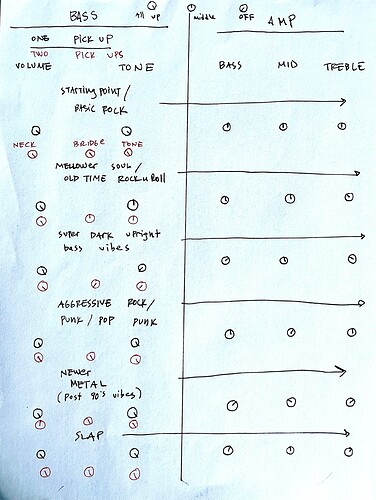Hi,
I’ve recently bought myself a new bass that can switch between active and passive. My previous bass was a passive bass. I bought the new bass, because I loved the sound and feel of it but I don’t really know much about the differences between active and passive and when to use either. Has anyone got a simple explanation of both active and passive and when to use? When looking up online, a lot of articles seem quite techy and wordy and I really need the lay man, beginner friendly explanation!
From my understanding, if you want to use the onboard EQ then you’re active. If you just want volume and tone then use passive.
Perfect, that makes sense - thank you!
It’s tone. Passive has more dynamics and the preamp could add compression or color to the tone. So a player might want a pure tone.
Or a player might want to shape the sound which is why you use a preamp, on board or on a pedal board
Or you battery dies
I rarely use the switch
Most often, when you have an active bass, you use it in that setting. Active here means it has an on-board pre-amp with some tone shaping possibilities (often 2-band EQ, sometimes 3-band EQ). This requires a battery, and when the battery dies (and you have no replacement at hand), you can keep playing by going over to passive mode. But then, as @Paul_9207 mentioned, your tone shaping capabilities are a bit more limited.
As with all controls, having more of them gives you more options, but also provides more opportunities to get lost in useless settings. Luckily, it’s fairly straightforward on most basses - play with the knobs and trust your ears!
This^^^ ![]()
What @joergkutter said.
To add one thing: When you’re playing around with your bass’s preamp (twisting knobs to different positions until you find a sound you like), look at the new positions your knobs are turned and make a mental note so you can set them that way again in the future.
Many players keep their bass knobs set at “12 o’clock” (meaning in the default or “home” position, commonly where you feel the knob “click” into place). Then, it’s simple to change one or more of your knobs to get a brighter or darker tone, as you choose.
When your tone knobs are set to the default position, your active preamp is neither adding (boosting) nor subtracting (cutting) your bass’s tone.
Sounds more complicated than it is so, yeah, just play around with the knobs and listen for setting combinations that sound good to you. After a while, you’ll find what you like best.
@Gio made a handy cheat sheet to preamp settings once upon a time
The life-saver switch for forgetful old me who often forgets to unplug the cable & comes back to a dead battery ![]()
I like the way Jack Bates illustrates it here ( though I am a bit biased as his dad is my favorite bassist and I own that bass ![]() ):
):
It’s about providing tonal variety more than anything else. I wouldn’t worry at all about the preamp sound being less “pure” or taking anything away - that’s almost never the case. It’s more about the preamp providing you more ability to shape tones, as Jörg and Mike said above. Often the preamp can help bring out tones from the pickups that were otherwise less noticeable, as Jack illustrates in that video - noticeable brightening before going in to the Chorus pedal, because he is probably raising the mids and treble. Can’t do that on a passive bass. (You can via EQ later though; preamp pedal, in the DAW, etc).
Thanks for reposting, never stumbled on that post. Very useful, thanks.
You all are absolutely amazing, thank you so much! Reading through your comments, it now makes far more sense to me. ![]()

